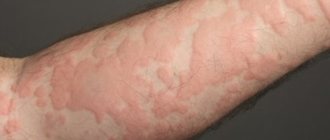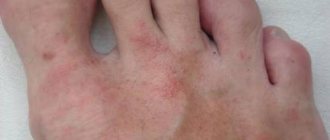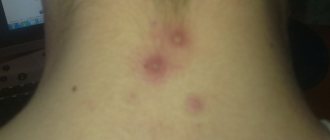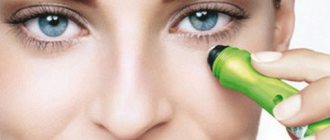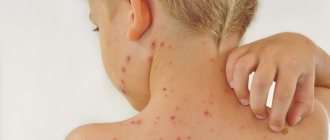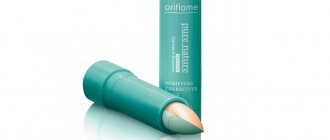Cholinergic urticaria
is a type of skin rash that occurs in some people when they sweat or overheat. The rash usually develops very quickly and goes away on its own without consequences. However, in some people, cholinergic urticaria adversely affects performance. Rarely, people with cholinergic urticaria may experience reactions that lead to a life-threatening allergic reaction. The word "cholinergic" refers to the nervous system that controls muscle contraction, dilation of blood vessels, and slowing of heart rate.
Cholinergic urticaria Photo: Wikipedia
Cholinergic urticaria - causes
Cholinergic urticaria can occur any time a person sweats or feels hot. The following events or situations can cause the development of cholinergic urticaria:
- doing exercises;
- hot bath;
- sauna and hot tub;
- high temperature in the room;
- hot weather;
- fever;
- stress;
- spicy food.
These situations raise a person's body temperature and the body begins to release histamine, a substance that can cause cholinergic urticaria in some people.
Treatment
Treatment of this form of urticaria gives results quickly and for a long time, only if complex therapy is used that takes into account the patient’s internal diseases. And the main task in eliminating the symptoms of urticaria is to identify and treat the underlying disease that triggered its occurrence.
Treatment of cholinergic and other forms of urticaria is discussed in the video below:
In a therapeutic way
Treatment of cholinergic urticaria is fundamentally different from the standard treatment regimen for skin and other types of allergies, since the reaction is caused by a substance that the body itself produces, and it also shows excessive susceptibility to its excess. Therefore, commonly used antiallergic drugs do not give a pronounced effect or are useless.
However, it is wrong to completely abolish antihistamines, since in many patients they are able to reduce itching, swelling, and also calm the patient.
The main local remedies for relieving skin symptoms are ointments, gels, creams containing Atropine and belladonna extract. They are used up to 2 - 3 times a day. La-Cri cream, Advantan, Fenistil-gel, Gistan-N provide a good therapeutic effect.
By medication
Treatment of patients with cholinergic urticaria with drugs involves the use of the following pharmacological blocks:
Due to the fact that the pathology occurs due to the release of acetylcholine, for the treatment of urticaria of this type, first of all, anticholinergic drugs are needed, which simultaneously have a calming effect:
- Bellantaminal, Bellaspon, Belloid (1 tablet 2 - 3 times a day for a month);
- subcutaneous injections of atropine sulfate solution 0.1% (in severe cases, many side effects).
Antiallergic drugs for this form of urticaria, as a rule, alleviate the symptoms if other signs of allergy are observed simultaneously with urticaria - lacrimation, conjunctivitis, rhinitis, sneezing, itching in the nose and eyes. The choice depends on the patient's sensitivity to a particular drug and its effectiveness.
For mild allergization, the use of histamine-suppressing agents, such as Telfast (180 mg on average), Claritin (10 mg) for a month, Ketotifen for a course of 3 months twice a day, 1 mg, is prescribed 1-2 times a day, for children from six months to 3 years - 0.5 mg in syrup. And also Tsetrin, Erius, Kestin, Elerta, Alerzina.
- For moderate severity of urticaria, first generation antihistamines with a sedative effect are used for 2–4 days by injection (intramuscular or intravenous): Tavegil 0.1%, Suprastin 2.5%.
- If the patient responds poorly to antihistamines that suppress histamine H1 receptors, H2 receptor antagonists are added: Cimetidine 300 mg up to 4 times a day, Ranitidine 150 mg, Famotidine 20 mg 2 times a day.
- If foci of itchy rashes spread throughout the body, causing sleep problems, nervous system disorders, general weakness, irritability, hormonal drugs are prescribed intramuscularly or intravenously for a short period of time: Dexamethasone 4 - 12 mg, Prednisolone 30 - 90.
In rare cases, glucocorticosteroids are recommended for a long term as basic therapy using injections every other day Prednisolone 20–40 mg every other day; Dexamethasone in a daily dose of 4 – 20 mg.
- In case of severe itching, especially against the background of recurrent cholinergic urticaria, which occurs in a chronic form, sedatives are required to avoid exhaustion of the nervous system:
Novopassit, Motherwort-forte in tablets, vitamin complexes B1, B6, B12, Neuromultivit, Milgamma and more serious remedies for severe severe itching: Phenobarbital, Atarax and other tranquilizers.
Indications for hospitalization
Indications for hospitalization:
- severe form of urticaria accompanied by developing swelling of the larynx, threatening suffocation;
- detachment of the upper layer of the dermis with extensive edematous rashes.
Prevention of cholinergic urticaria in children and adults is discussed below.
Cholinergic urticaria - symptoms
Cholinergic urticaria occurs immediately after a person begins to sweat or overheat. The rash can be located anywhere on a person's body, but most often on the torso or arms. Typical signs and symptoms of the rash include:
- itching or tingling when the rash appears;
- small welts, red, raised bumps on the skin;
- swelling of the skin.
The symptoms of cholinergic urticaria are not serious, and the rash will go away on its own within an hour of its appearance.
Symptoms
Allergic symptoms appear immediately after exposure to the provoking factor, on average it lasts from 5 to 60 minutes. The symptoms of urticaria are pronounced and difficult to confuse with other types of allergies.
First, a small rash appears in the form of bubbles 1-3 mm in size. They are pinkish in color, with a richer, bright red color at the edges. The skin around the elements of the rash is swollen. Elements of the rash look like bumps raised above the skin.
The rash causes severe discomfort to the patient and may cause burning or itching. More often, the bubbles are localized in the upper part of the body: on the neck, chest, shoulders. Very rarely, the rash can be seen on the abdomen or lower extremities.
With an excessive immune response, symptoms are more severe. Not only local, but also general symptoms appear. These are nausea, vomiting, increased salivation, and stool upset. Relapses of the disease are accompanied by a sudden increase in body temperature.
Cholinergic urticaria - diagnosis
Cholinergic urticaria Photo: Wikipedia
A doctor diagnoses this condition from the person’s described symptoms. However, your doctor may do tests to confirm the diagnosis of cholinergic urticaria.
Doing exercises
When a person exercises, a doctor will be able to monitor for signs of cholinergic urticaria.
Heat test
The person will sit in a warm room or warm water while the doctor checks the skin for signs of cholinergic urticaria.
Methacholine test
The doctor injects the drug methacholine into a person's skin to see the reaction.
Prevention
Knowledge about provoking factors that can cause cholinergic urticaria is the basis for the prevention of this pathology. Relapse can be prevented by limiting or completely eliminating contact with the provoking factor.
Preventative measures to pay attention to:
- do not use hot water when taking a bath or shower (not higher than 36 – 37C);
- avoid situations dangerous due to nervous breakdowns, stress, emotional overstrain;
- if it is not possible to avoid a stressful situation (exam, admission or dismissal from work, court, etc.), you must take and have the most suitable sedatives with you in advance;
- since cholinergic urticaria develops only with an existing predisposition to allergies, as well as diseases that provoke the release of acetylcholine, there remains a need to maintain a hypoallergenic diet, even if the analysis of allergen samples did not reveal specific irritants;
This means excluding hot, hot, spicy foods, warming drinks, alcohol, dark chocolate, pepper, mustard, and adjika from your diet.
- avoid excessive physical exertion and profuse sweating during physical and emotional stress, for which you need to stop working, playing sports, dancing when even light perspiration appears on the face;
- if urticaria is accompanied by cough, bronchospasm, lacrimation, sneezing, conjunctivitis and other manifestations of allergies, it is urgent to consult an allergist or pulmonologist in order to avoid the development of internal pathologies and the possible development of anaphylactic shock.
If even a slight itching appears, it is advisable not to wait, but to use traditional medicine to eliminate it:
- Brew nettle (a tablespoon) in 250 ml of boiling water, let stand, strain and drink like tea. After 2 days the itching subsides.
- Brew wild rosemary (2 tablespoons) in 1 liter of boiling water, leave until cool, strain and dissolve for bathing in a non-hot bath. Use celandine in the same way.
- Squeeze the juice from dill and apply it to itchy rashes.
Let's talk further about the complications of urticaria.
Diet for cholinergic urticaria
A low-histamine diet may help with chronic hives. Scientists believe that the diet will help the body absorb less histamine, which reduces the allergic reaction.
People should reduce or avoid:
- salty food;
- fish and shellfish;
- foods high in preservatives and additives;
- vinegar;
- dairy products;
- alcohol;
- nuts;
- reduce your consumption of fruits and vegetables.
Cholinergic urticaria - complications
However, some people may have severe reactions to cholinergic urticaria.
- headache;
- diarrhea;
- nausea;
- breathing problems;
- strong heartbeat;
- stomach cramps.
In some cases, people with severe reactions to cholinergic urticaria may develop anaphylaxis, which requires emergency medical attention.
Diagnostics
To diagnose urticaria, you need to contact a dermatologist, allergist-immunologist . Help to identify pathology:
- general urine analysis,
- blood tests for eosinophils and allergens,
- blood for antibodies
- biopsy of skin tissue to exclude inflammation,
- studies for differentiation with other similar skin pathologies.
To determine the type of urticaria, a provocative test is performed by injecting a substance similar to acetylcholine into the body. If an allergic reaction appears after a few minutes, a cholinergic type of urticaria is diagnosed.
Another diagnostic option is stimulation using thermal provocation. To do this, the patient puts his hands in hot water, which generates a cholinergic reaction: redness of the skin, blisters and itching.
Prevention of cholinergic urticaria
People who experience cholinergic urticaria should avoid exercise that causes excessive sweating. Likewise, they should avoid high air temperatures. This is especially true during the summer months.
Your doctor will likely prescribe antihistamines to help prevent allergic reactions. Other treatments include beta blockers and immunosuppressants. People who experience frequent or prolonged symptoms should talk to their doctor about ways to prevent the condition.
Therapy methods
Treatment of cholinergic urticaria should be comprehensive . It includes the elimination of concomitant pathologies and provoking factors, alleviation of the patient’s condition, and relief of symptoms. For this purpose:
- medications,
- hypoallergenic diet,
- folk methods.
Medication therapy
Drug treatment includes:
- Antihistamines only of the latest generation - Cetrin, Erius, Claritin, Telfast. Prescribed for unbearable itching, swelling, lacrimation and other signs of allergies. Such drugs have an anticholinergic effect and block neurotransmitters. Other allergy medications are not effective for this type of hives because it is caused by a substance produced by the body.
- Non-hormonal ointments for treating the skin and eliminating itching, burning, and relieving the inflammatory reaction - Fentistil-gel, Psilo balm. Products based on atropine and belladonna extract have a good effect.
- Hormonal drugs for severe disease - injections of Dexamethasone and Prednisolone, Sinaflan ointment, Hydrocortisone.
- Sedatives - Novo-Passit, Phenobarbital, Atarax, Valerian.
- Vitamins B and C to boost immunity.
Diet
Dieting involves excluding allergenic foods and foods that cause sweating.
Prohibited:
- spicy, hot food,
- alcohol,
- spices,
- citrus,
- chocolate,
- nuts,
- seafood,
- honey,
- egg yolk.
Products containing choline (B4), which promotes the synthesis of acetylcholine in the body, are also not recommended. These are meat products, milk, liver. Their use should be reduced to 3 times a week.
Traditional methods
Treatment of cholinergic urticaria with unconventional methods is recommended as additional therapy . Folk remedies help alleviate the patient's condition, eliminate swelling, redness, and itching.
Effective home remedies:
- Nettle decoction. It has a calming effect, improves immunity, and cleanses the body. Two tablespoons of crushed leaves need to be poured into 400 ml of boiling water. Let it brew for half an hour. Drink the infusion before meals 3 times a day, 70 ml. The course of treatment is 10 days.
- Mint compress to eliminate burning and itching. Pour water (1:2) over the mint, bring to a boil and leave to brew for 20 minutes. Prepare a paste from the leaves, apply to the affected areas and secure with a gauze bandage. This compress can be used for 20 minutes and then washed off with water.
- Baths with wild rosemary or celandine eliminate itching. Bring two tablespoons of the plant to a boil in 1 liter of water. Leave for 20 minutes, strain and add to water. Take a bath every night at night for 8 days.
Complications
Urticarial rashes that occur with cholinergic urticaria are accompanied by burning and intense itching.
Cholinergic urticaria can lead to the following consequences:
- infection of skin scratches and development of purulent processes;
- swelling of the larynx;
- anaphylactic shock.
What is “urticaria”?
Few diseases are named as figuratively as urticaria. What associations does this word evoke for you? The name of the disease comes from the Latin word urtica - nettle. In most cases, itchy, red blisters quickly appear and disappear without a trace in a period of several minutes to several hours. Please note that these are blisters, not spots, not bubbles. In half of patients with urticaria, along with blisters, swelling of various parts of the body occurs. This is the same disease, just deeper layers of the skin are involved in the painful process. Often patients correctly diagnose themselves, but diagnosis in the case of urticaria is the beginning of a difficult path to finding the causes of the disease.
How common is “urticaria”?
Hives are a common illness, if that's any consolation. True, this was not always the case. In the distant past, this disease was apparently quite rare, and its first reliable description was made in the 15th century: the English king Richard III developed an itchy skin reaction, reminiscent of a nettle burn, after he ate strawberries. It is believed that such a disease was rarely mentioned in the medical literature of the Middle Ages because it did not occur very often. The state of affairs changed dramatically in the subsequent and especially in the 20th century. According to some data, now up to a quarter of the world's population suffers from urticaria, but, fortunately, in 60% of cases we are talking about a short-term, not too severe, single episode in a person’s life.
Why is disease classification needed?
Carrying out an analysis of each specific case, the doctor tries to identify certain characteristic features that allow him to compare this case with many similar ones. This is called classification, which allows for more precise examination and treatment. The classification of urticaria involves division into acute and chronic forms, i.e. takes into account the duration of the disease. If urticaria lasts less than 6 weeks, then it is an acute form; if it lasts more than 6 weeks, it is chronic. Patients with the acute form of urticaria have a better chance of recovery and do not require examination; the chronic form requires extensive examination and long-term treatment.
In addition, urticaria is divided according to the possible causes of the disease. This is what is known as physical urticaria. Blisters develop in response to an external physical stimulus. Depending on the type of stimulus, urticaria can be: dermographic, pressure-delayed, cold, thermal, solar, vibration, cholinergic, aquagenic. Patients with dermographic urticaria may be a living letter. The “written” word, rather the word inscribed on such patients, remains for some time. This word is a fancy urticaria. The very name of this type of urticaria comes from the Greek. derma - skin and grapho - writing. Delayed pressure urticaria appears as an itchy blister or swelling several hours after exposure to any part of the body, often after carrying heavy bags, backpacks, etc. A common type of urticaria is thermal urticaria, which develops after exposure to a temperature stimulus. Many people think that cold urticaria is a winter disease among residents of the northern regions of Europe and America.
Indeed, sub-zero temperatures often cause exacerbation of the disease, but hives on a hot summer day after swimming in a chilled pond are not uncommon. Another summer danger is the sun. Exposure to ultraviolet rays can cause red, itchy blisters. Teenagers often turn to an allergist with complaints of very small blisters with severe itching after physical activity, overheating, or excitement. This is cholinergic urticaria.
Allergic urticaria itself is associated with the action of a wide range of allergens. Allergens in this case can be food, medicinal, pollen, household, epidermal allergens, insect poisons that enter the human body through stings, viruses, parasites, simple chemicals, cosmetics, and household chemicals.
Sometimes there are special types of urticaria . Contact develops after contact with an allergen (latex gloves, antibiotic ointment, etc.), as well as an irritating substance (plants, jellyfish, etc.). Urticarial vasculitis is a special type of urticaria, in which the rash persists for more than 24 hours, leaves behind bluish spots, is more often bothered by a burning sensation than itching, and sometimes urticaria is accompanied by a rise in temperature and joint pain.
An unusual type of urticaria is pigmented urticaria , or cutaneous mastocytosis. Outside of an exacerbation, reddish-brownish spots are observed on the patient’s skin, which turn red and swell when scratched. The same can happen after being stung by a bee, taking certain medications, or drinking alcohol. Hereditary angioedema is considered separately. This disease develops due to a deficiency or dysfunction of one of the enzymes of the immune system - inhibitor of the 1st complement component. The inhibitor inhibits the development of the local inflammatory process and the associated vasodilation, sweating of the liquid part of the blood through the vascular wall, and the attraction of inflammatory proteins that enhance all these processes. This missing component stops the cascade of inflammation that develops in response to a huge number of provoking factors. The inflammatory process protects the body from unwanted invasions of infectious or non-infectious origin. But such invasions occur continuously. Therefore, excess inflammation must be interrupted at the very beginning, which is what the inhibitor of the 1st complement component does.
Possible causes of hives
- Medicines : antimicrobials (penicillins and sulfonamides), aspirin, voltaren, blood components and blood substitutes; muscle relaxants, antiepileptics, contraceptives.
- Food products (fish, nuts; products, histamine-releasing products - cheeses, beer, wine, preservatives, dyes, flavor enhancers).
- Inhalation agents (latex, pharmaceutical or chemical products).
Fundamentally similar mechanisms underlie different allergic diseases. The difference is in which tissue, in which organ the allergic process will develop. The specific external manifestation of the allergy, the specific clinical picture of the allergic disease will depend on this.
In order for the body to respond with an allergic reaction, it must first acquire sensitivity (sensitization) to the allergen. Creating this sensitivity is the process of training the immune system to respond to an allergen. The first cells involved in this process are the so-called dendritic (branched, tree-like) cells located under the surface layer of the epithelium of the skin, mucous membranes of the gastrointestinal tract, and respiratory tract. The main function of these cells is to detect foreign proteins that may enter the body. Having discovered such proteins, cells capture them and “cut” protein molecules into small particles (epitopes), presenting the latter to T lymphocytes. T lymphocytes are the master controllers of the immune system, deciding what to do against foreign proteins and what instructions to send to other cells. In the event of allergens (pollen proteins, food, household allergens) entering the body, T cells interact through a bridge consisting of the resulting epitopes with B lymphocytes and instruct the latter with special instructor molecules (interleukins 4 and 13) so that B lymphocytes began to produce antibodies to the selected epitope. In case of allergies, these antibodies belong to immunoglobulin E (immunoglobulin E) or in its abbreviated form - IgE.
This is a very important molecule for allergies. It equips the cells that execute the allergic reaction with an allergen recognition device. This is achieved by binding the IgE antibody to a specific receptor on the cell surface. Thus, cells armed with IgE antibodies are always ready to recognize the incoming allergen and respond to it.
These cells, the main cells of the allergic reaction, are mast cells. They are called so because their interior is packed with a large number of granules containing biologically active substances that can cause vasodilation and redness of the skin, tissue swelling and blister formation, contraction of smooth muscles, irritation of nerve endings and itching and other symptoms. Among the biologically active substances contained and produced in mast cells, histamine is the most important for an allergic reaction. As soon as the mast cell receives an irritating stimulus, histamine is released from it, as well as other biologically active substances. Depending on the tissue in which this process occurs, organ manifestations of allergy will appear, making up the clinical picture of the disease.
With urticaria, painful changes occur in the upper layer of the skin and consist of the formation of a blister and redness of the skin, accompanied by itching. The main cell that forms the blister is the mast cell. The fact that histamine is the most important participant in the skin reaction that occurs is confirmed by the fact that applying it to the skin of a healthy person causes all the external signs of urticaria: redness, blister, soreness, itching. All these changes are reversible, i.e. the vessel wall returns to normal after some time, the liquid part of the blood goes back into the vessel. Histamine breaks down over time. If these processes occur in the deeper layers of the skin, swelling appears, which disappears much more slowly.
In addition to allergy, other types of immunological mechanisms are also believed to be involved in the development of urticaria. For example, the accumulation in the body of so-called autoantibodies directed against IgE or its receptor on a mast cell may be accompanied by irritation of the mast cell by the corresponding immune complex formed on its surface. Such a mechanism may be involved in clinical forms of chronic urticaria, since the formation of autoantibodies is constantly and long-term maintained in the body.
What if hives occur?
First, you need to see a doctor. Urticaria is treated by an allergist. If there is no allergist in your region, a dermatologist will take care of you. Patients often say: “Doctor, I have an allergy.” This is a persistent myth. She is not always allergic. You have hives, just say so. A conversation with a doctor and an examination will help you find out what type of urticaria you have. The doctor will ask you many questions:
- when and under what conditions did the first blisters appear: acute respiratory or other diseases, taking medications, surgery, blood transfusion, stress, visiting a restaurant, traveling to a different climatic zone, especially with the risk of contracting some diseases characteristic of this zone, etc. .;
- you have allergic diseases;
- be sure to tell your doctor about infectious hepatitis, parasitic infestations, rheumatic diseases and other confirmed diseases that you have been diagnosed with, even if it seems to you that they are not related to urticaria;
- you need to know how long one blister lasts. Outline the blister that appears with a pen, try to notice the time from the appearance to the complete disappearance of one element. Longer persistence may be a sign of urticarial vasculitis. Be sure to tell your doctor if a bruise remains after the blister disappears. Do you have swelling and on what parts of your body?
- You've probably tried taking antihistamines. How do you evaluate their effectiveness? Please note that the disappearance or even a slight decrease in itching while blisters persist indicates the effectiveness of the drugs;
How should I be examined?
In addition to examining the skin and mucous membranes, the doctor will measure blood pressure and skin temperature, examine joints, listen to the lungs, and examine the abdominal organs. You may be examined by:
- general blood analysis . This study may indicate an inflammatory or allergic process in the body;
- A general urine test can reveal damage to the urinary system.
To exclude many causes of long-term urticaria (chronic infection (bacterial, viral, fungal), endocrine and oncological pathologies, autoimmune diseases, parasitic diseases, autonomic dysfunction), the doctor may recommend the following studies:
- blood chemistry;
- rheumatological tests;
- determination of thyroid function;
- bacteriological examination of feces (intestinal dysbiosis);
- bacteriological cultures from the oropharynx and other possible foci of chronic infection;
- parasitological examination (by blood or feces);
- search for probable viral infections, primarily viral hepatitis;
- Ultrasound examination (ultrasound) of the abdominal organs;
- EGDS (esophagogastroduodenoscopy) is a study of the condition of the mucous membrane of the stomach and duodenum. Sometimes an ulcerative lesion of the mucous membrane does not manifest itself as anything other than urticaria.
If physical hives are suspected, the doctor will perform certain tests. You may have to pedal a bicycle (this is how cholinergic urticaria is detected), although sometimes running around the floors is enough. Don't be offended if your doctor tries to scratch the skin of your forearm looking for dermographism. A very revealing test with an ice cube applied to the forearm area for 10-15 minutes.
With cold urticaria, a blister appears in this place, shaped like an ice cube. You may have to walk down the corridor with a heavy string bag on your shoulder. Swelling at the site of gravity may appear after a few hours, as in the case of delayed pressure urticaria. Urticaria may be a symptom of another disease (hepatitis B and C, yersiniosis, infectious mononucleosis, autoimmune thyroiditis, rheumatic disease, infection of the stomach with a microorganism called Helicobacter pylori), may appear as a symptom of an allergic reaction to stings by bees and wasps, taking allergenic drugs you medicines, food products. Sometimes an extensive examination leads to the conclusion that you are in exceptional health. In this situation, urticaria is called idiopathic, i.e. urticaria from no one knows why.
Treatment
It is necessary to exclude everything that can cause exacerbation of urticaria. Let's start with diet. If you know for sure about foods that are allergenic to you, exclude them. Food allergies require the complete exclusion of identified food allergens. You should not try to include an allergen in your diet, hoping that the food allergy will disappear. If you exclude allergens, the hives will disappear very quickly, within 1-2 days. In a restaurant, it is necessary to ask about the composition of complex products and warn about a possible allergic reaction. If you do not have detailed information, refuse the dubious pleasure of eating an unusual dish.
There is a concept of histamine liberators . This is a whole group of products, which in themselves are not allergens, but have the ability to cause hives. They are able to stimulate the mast cell to release histamine. These products include: chocolate, coffee, seafood, smoked meats, spices, honey, food additives, preservatives, flavor enhancers, dyes. If urticaria is associated with taking histamine liberators and all of the above, improvement will occur in 2-3 weeks. The doctor recommends you a list of permitted foods. Your task is to follow it and keep a “food” diary to identify “bad” foods.
If you have a cold allergy, you need to limit your exposure to cold streets, dress warmly, avoid drinking cold drinks and foods, and do not try to become a “walrus.” For dermographic urticaria, avoid tight clothing. For delayed urticaria from pressure, simple measures such as widening the straps of a backpack or bag to reduce the force of pressure on the surface area of the skin provide relief.
For solar urticaria, it is necessary to use sunscreen (clothing and medicinal cosmetics).
Vibration urticaria eliminates the possibility of working with a jackhammer or mixer. A person with cholinergic urticaria is unlikely to be an athlete.
If you have chronic urticaria, we recommend that you stop taking antipyretic drugs such as aspirin. Taking these medications during a urticaria flare-up may make the flare-up worse. Some patients cannot take such drugs at all, and accidentally taking them during a calm period can lead to an exacerbation of urticaria.
When is it necessary to call an ambulance and agree to hospitalization?
Generalized urticaria, i.e. rashes all over the body, draining, swelling in the oropharynx (tongue, larynx), especially when hoarseness, difficulty swallowing, breathing occur - all these are conditions when you should immediately seek medical help. However, there is no need to panic; angioedema never develops within a few seconds or minutes. There is enough time to seek medical help. Sometimes hives accompany a severe allergic reaction. In such cases, in addition to rashes, coughing, wheezing, itching of the eyes and nose may cause discomfort; there may be cramping pain in the abdomen, involuntary urination and defecation. These are serious symptoms of anaphylactic shock, which is life-threatening. In this situation, assistance must be provided immediately.
What are H1 blockers or antihistamines?
Antihistamines are the mainstay of treatment for acute and chronic urticaria. You already know that the main cell in the development of urticaria is mast. It releases many biologically active substances that cause allergic inflammation, i.e. a blister. The most important compound among these substances, protein, is histamine. But histamine can only act after binding to its own receptor. Histamine is the key that opens the door labeled "URTICS". Before World War II, scientists synthesized the first antihistamine compounds. These connections, like a key, fit well into the same lock, but did not allow the door to open, and under these conditions histamine did not have its effect. First generation antihistamines have been and remain effective against urticaria. But, along with the reduction and disappearance of itching and blisters, severe drowsiness, inability to do normal activities, dry mouth, and difficulty urinating may appear. First-generation antihistamines bind to their receptors for a short time, so you need to take the medicine several times a day. In addition, after 7-10 days of constant use, sensitivity to them decreases, and they cease to have their therapeutic effect. In the 60-70s of the 20th century, it was possible to find out that the histamine receptor is not homogeneous, but is represented by different receptor subtypes. It further turned out that the clinical manifestations of allergies are associated with the action of histamine not on all receptor subtypes, but only on its 1st subtype (H1 receptor). Then it became clear that in order to obtain a more effective antiallergic drug, it was necessary to search for compounds that selectively interact with the H receptor. Such compounds were soon obtained, and the drugs created on their basis were called 1-1, -antihistamines of the second generation. The creation of second-generation antihistamines made it possible to avoid many problems. The advantages of such drugs include: selective action specifically on H1 receptors, once daily dosing, non-addiction, and good tolerability.
Other medicines
Sometimes antihistamines don't help. The doctor begins to search for an effective medicine. These may be medications that block other types of histamine receptors - H2 receptors. Do not be surprised that you are recommended a drug whose main indication is gastric ulcer. There are observations indicating that in some patients with urticaria, a combination of such drugs with H-antihistamines may have a therapeutic effect.
Sometimes the doctor prescribes sedatives. Firstly, the most painful symptom of urticaria is itchy skin, and secondly, urticaria is sometimes associated with severe stress, and in this case only sedatives lead to a cure. In some cases, the allergist considers it necessary to recommend antibacterial, antifungal, and antiviral medications to you. You may also need medications used in rheumatology. This once again proves that urticaria is a universal skin response to many painful conditions.
Once again about hormones
Very often we hear: “Doctor, I refuse hormonal medications!” Several types of hormonal drugs are used in medical practice. Among them are hormones of the thyroid gland, pancreas, and adrenal glands. We are interested in glucocorticosteroid (GCS) hormones. These synthetic drugs are used in almost all areas of medicine. If urticaria cannot be treated with antihistamines, if it is severe and accompanied by swelling of the soft tissues of the oropharynx, there may be a need for GCS drugs. The duration of prescription and dose of GCS drugs recommended by allergists, as a rule, do not cause complications: weight gain, bone loss and, consequently, fractures, addiction. The treatment uses the anti-inflammatory effect of GCS drugs. These medications are not the last resort for hives, as some people think. This may just be a phase in treatment. Just please do not use GCS ointment on blisters. If you have several blisters, the urticaria is not so severe that corticosteroids should be used. If blisters cover the entire body, then you will have to cover yourself from head to toe, not to mention the fact that urticaria is not a skin disease, like neurodermatitis or eczema.
